There are over 10,000 species of bird, and while they all share obvious similarities, it is the variations between species that make them so fascinating to study.
One area of particularly interesting variations is the tail. In many species, the male relies on his attractive tail feathers to entice a mate.
In terms of flight, a long tail would seem to be a disadvantage, as a short flexible tail is much more useful for performing the rudder function required.
However, studies have shown that in some species a long tail can be beneficial during flight, particularly in species that need high maneuverability, for example, those that feed while in the air.
11 Birds with Long Tails
Let’s take a closer look at some birds with impressively long tails!
1. Fork-tailed Flycatcher
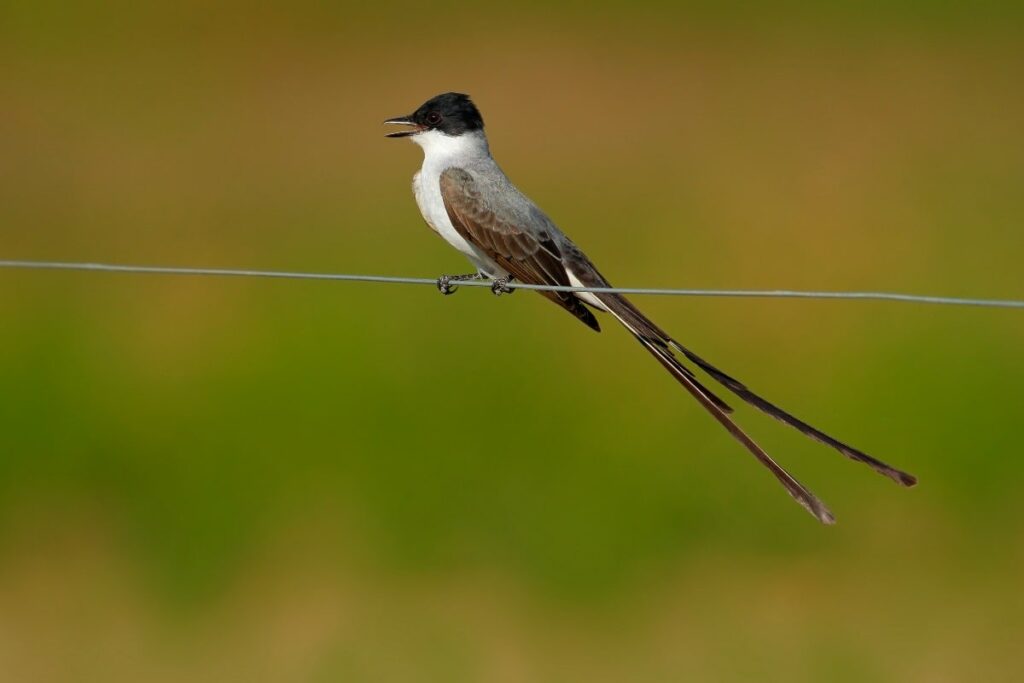
- Scientific name: Tyrannus savana
- Size: 3.5- 4.7 in (9-12 cm) in length excluding tail
- Weight: 0.99-1.13 oz (28-32 g)
- Tail length: 7.5-11.4 in (19-29 cm)
While the forked tail is present in both the male and female of the species, it is usually much smaller in female and juvenile birds. The tail of an adult male can be two to three times the length of the bird’s body and forms part of his aerial courtship display.
Fork-tailed flycatchers can be found in a wide range of habitats, including light forest or grassland areas, pastures, mangroves, and forest edges.
These birds can be observed across America, but their breeding range is from central Mexico to central Argentina, where for the most part they can be found all year round, though those in the south tend to migrate north in the winter.
Fun fact! The males’ wings can make a dry, crackling sound, which it is thought they use to startle predators.
2. Greater Bird-of-Paradise
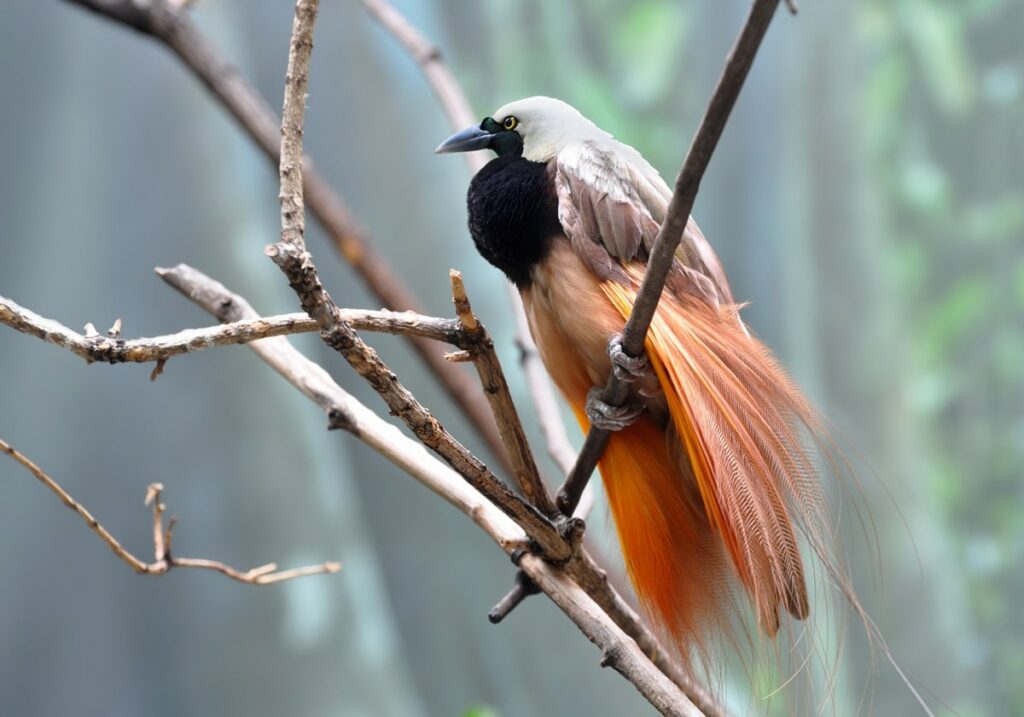
- Scientific name: Paradisaea apoda
- Size: 13.7-16.9 in (35-43 cm) in length excluding tail
- Weight: 6-6.1 oz (170-173g)
- Tail length: 24-28 in (61-71.1cm)
As its name suggests, the greater bird-of-paradise is the largest of the Paradisaea genus. Both males and females have maroon-brown plumage, but the male has large yellow plumes on its flank and two long tail wires. The male also has a green throat and a silvery-yellow crown, nape, and neck.
Birds-of-paradise are renowned for their eccentric courtship behavior, and greater birds-of-paradise are no exception. They gather in a ‘court’ with up to 15 other males and then perform an elaborate dance, using their wings, plumes, and tail wires as part of the display.
The population resides in the southwest of New Guinea and the Aru Islands in Indonesia, preferring lowlands and hill forest areas.
Fun fact! Between 1909 and 1912 a small population was introduced to Little Tobago Island in the West Indies to try to avoid the species going extinct, and the bird still appears on Trinidad and Tobago’s $100 bill.
3. Indian Peafowl

- Scientific name: Pavo cristatus
- Size: 39-45 in (95-115 cm) in length excluding tail
- Weight: 6.1-13.2 lb (2.75-6 kg)
- Tail length: 55.1-63 in (140-160 cm)
Commonly referred to colloquially as the peacock, the Indian peafowl will often be the first bird that comes to mind when you think of birds with long tails.
The male Indian peafowl is instantly recognizable by its spectacular iridescent blue-green plumage and incredible train of feathers with brightly colored eyelike markings. These feathers are raised into an eye-catching fan as part of their courtship display.
By contrast, the female is much plainer, with iridescent green feathers only on the lower neck, and otherwise bearing white and dull brown plumage, with no train.
The Indian peahen is native to the countries of the Indian subcontinent, preferring dry lowland areas. However, treasured for their beauty, the birds have been introduced across the world, including the United Kingdom, the United States, and South Africa.
Fun fact! The Indian peafowl is a sacred bird in the Hindu culture and is the national bird of India.
4. Long-tailed Widowbird
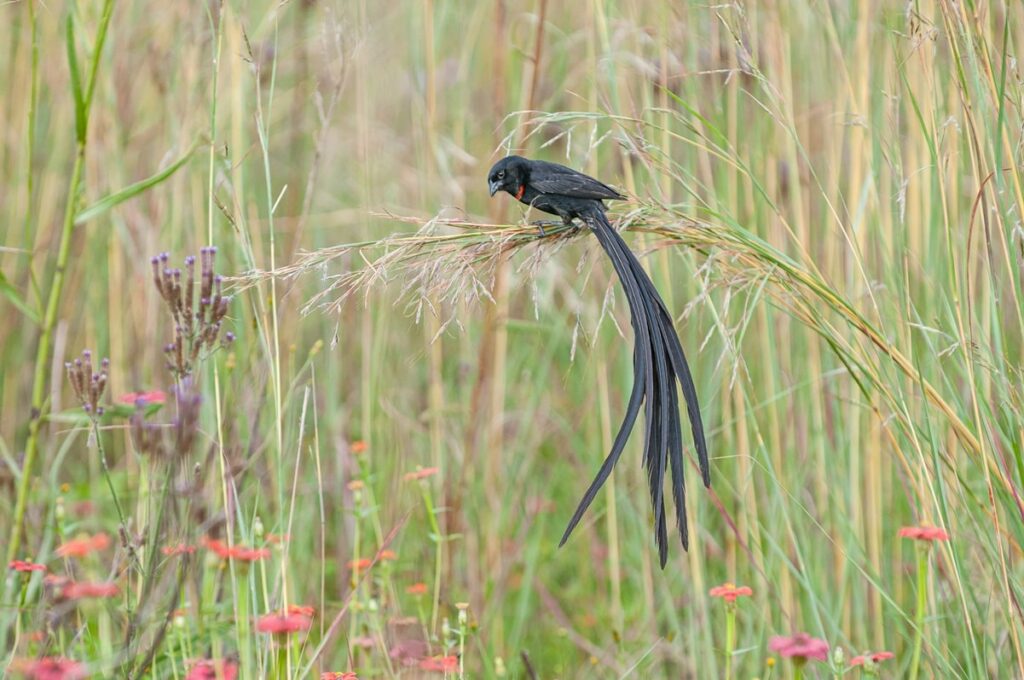
- Scientific name: Euplectes progne
- Size: 5.9-8.3 in (15-21 cm) length excluding tail
- Weight: 0.9-1.6 oz (25-46g)
- Tail length: 17.7-19.7 in (45-50cm)
The long-tailed widowbird is found predominantly in South Africa, but also in pockets across the African continent. It is one of the most common birds in areas where it is found, and males are instantly recognizable by their distinctive long tails.
Adult males are almost entirely black, with orange and white shoulders. Their tails are made up of 12 feathers, of which between six and eight are around 50 cm long, more than double the length of their bodies.
The tail is used as part of their courtship, when males fly with their tails drooping and spread.
Females and juvenile males are much less noticeable, with tawny brown plumage, more subtle shoulder coloring, and a much shorter tail.
Fun fact! Their long tails make it impossible for male long-tailed widowbirds to fly in the rain.
5. Marvelous Spatuletail
- Scientific name: Loddigesia mirabilis
- Size: 1.2-1.6 in (3-4 cm) length excluding tail
- Weight: 0.007 oz (3 g)
- Tail length: 2-5.1 in (5-13 cm)
Although this bird’s tail is the shortest on our list, it’s still around three times the length of this little hummingbird. The male marvelous spatuletail has two outer tail feathers with bare shafts that cross over each other and terminate in purplish-black spatules.
The female also has two outer tail feathers, but these are shorter and don’t have the spatules at the end. Males have mostly green plumage, with a blue crest and blue-green chest, while females are also green but without the blue highlights.
The marvelous spatuletail is non-migratory and can only be found in a small part of northern Peru. It prefers to live on the edges of mature forests and is particularly partial to hiding in dense Rubus thickets.
Fun fact! The marvelous spatuletail has been categorized as endangered since 2000. The males are hunted as their dried hearts are used in traditional medicine as an aphrodisiac.
6. Reeves’s Pheasant

- Scientific name: Syrmaticus reevesii
- Size: 29.5-43.3 (75-110 cm) length excluding tail
- Weight: 33.5-53.9 oz (0.949-1.529 kg)
- Tail length: 39.4-94.5 in (100-240 cm)
According to the Guinness World Records, our next bird officially has the longest tail feathers of any bird in the world. The Reeves’s pheasant was awarded longest natural tail feather in 2008 at a whopping 240cm!
Both males and females have a mottled brown plumage, though the male has warmer reddish tones, and males have a white head, with a narrow black band across the eye.
The male’s tail is silvery-white, barred with chestnut brown, while the female’s tail is shorter with greyish brown tail feathers.
The Reeve’s pheasant is native to central and eastern China but has also been introduced to the United States, the United Kingdom, France, and the Czech Republic. They prefer a mild climate and choose to live in evergreen forests and woodland.
Fun fact! The male’s tail grows around 12 in (30 cm) a year.
7. Resplendent Quetzal

- Scientific name: Pharomachrus mocinno
- Size: 14–16 in (36 to 40 cm) length excluding tail
- Weight: 6.3-7.4 oz (180-210 g)
- Tail length: 35-39.4 in (90-100 cm)
As with many of the birds in this list, it is the male resplendent quetzal that has a long tail. In preparation for courtship, the male grows a pair of ribbon-like tail feathers that can reach an impressive three feet long!
In both males and females, their green plumage iridesces from green-gold to blue-violet, offering superb camouflage in the rainforest canopy during wet weather. They also have a red chest and a small crest of yellow and green feathers, though all colorings are more muted in the female.
These birds choose to make their home in tropical rainforests, particularly mountainous cloud forests, and during the mating season will migrate from the slopes to the canopy. The resplendent quetzal is endemic across Central America, from southern Mexico down to western Panama.
Fun fact! The quetzal is the national animal of Guatemala, where it appears on both the country’s flag and its coat of arms, and also gives its name to the country’s currency.
8. Ribbon-tailed Astrapia
- Scientific name: Astrapia mayeri
- Size: 12.6-13.8 oz (32-35 cm) length excluding tail
- Weight: 4.7-5.8 oz (134-164 g)
- Tail length: 39.4-49.2 in (100-125 cm)
The second bird-of-paradise to make this list is the ribbon-tailed astrapia, the most recently discovered member of this family.
The male grows twin white ribbon-like tail feathers during mating season, and this train can reach up to an incredible four feet long, but will then be shed at the end of the mating season.
The males have a velvet-black body, with an iridescent green crest and chest, while the female has similar markings but is much duller in color, with no long tail feathers.
The ribbon-tailed astrapia is endemic to a particular area of Papua New Guinea, located in the western section of the central highlands, thriving in upper montane and subalpine moss forests and forest edges.
Fun fact! The male ribbon-tailed astrapia has the longest tail-to-body ratio of any bird in the whole world!
9. Superb Lyrebird
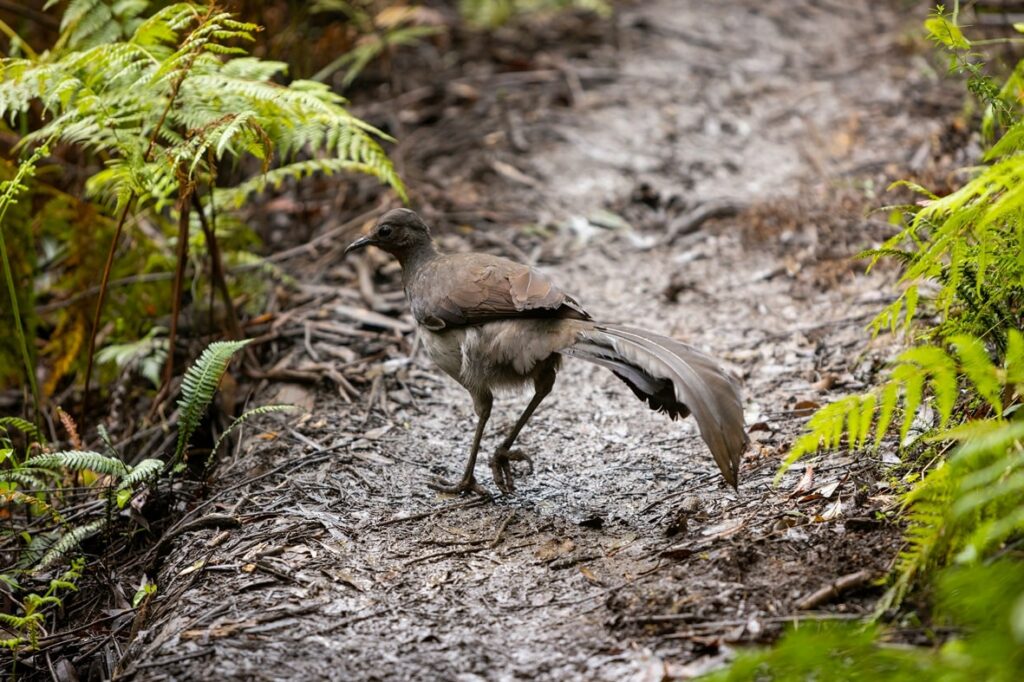
- Scientific name: Menura novaehollandiae
- Size: 11.8-15.7 in (30-40 cm) length excluding tail
- Weight: 31.7-38.8 oz (0.9-1.1 kg)
- Tail length: 28 in (70 cm)
The superb lyrebird gets its name from the shape of the male’s ornate tail, with the two broad S-shaped outer feathers said to resemble the shape of a lyre. These feathers are banded with brown and buff coloring and a black club-like tip.
But it doesn’t end there! Between these outer feathers are 12 fluffy-looking filamentous feathers that are dark above and silvery underneath. In the center of this spectacular tail are two dark silver wiry feathers.
The tail of the female is much less decorative, with shorter outer feathers and plain, broad feathers instead of filamentaries. In both males and females, the plumage is mainly dark brown on the body, greyish-brown underneath, and with red tinges to the flight feathers.
The superb lyrebird makes its home in forests in the southeast of Australia and in southern Tasmania, where the birds were introduced in the 1930s amid fears the bird was at risk of extinction.
Fun fact! The superb lyrebird is an excellent mimic, able to imitate a wide range of other birds, but also marsupials and even manmade sounds, such as chainsaws, car alarms, and camera shutters!
10. Turquoise-browed Motmot
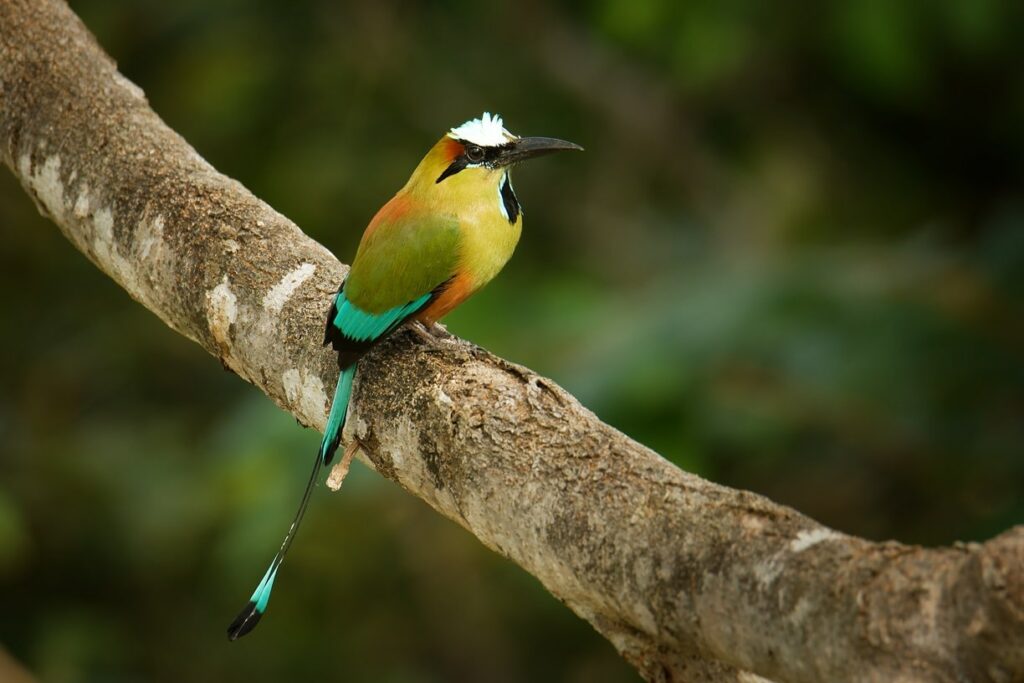
- Scientific name: Eumomota superciliosa
- Size: 4.3 in (11 cm) length excluding tail
- Weight: 2.3 oz (65 g)
- Tail length: 8.7 in (22cm)
Unlike many long-tailed birds, the extraordinary tail of the turquoise-browed motmot is seen in both males and females. Interestingly, while the male uses the tail to lure a mate, both sexes wag their tales to deter predators.
Both males and females have two long feathers in their tails, with a bare shaft and then a racket-shaped end. The rackets are turquoise, with a black tip.
While it takes its name from its turquoise eyebrows, there are further turquoise signatures on the wings and main tail, which are also black-tipped. The main plumage is grey-green with orangey-red highlights.
This bird is common across Central America, from the southeast of Mexico right down to Costa Rica. It prefers to make its home in relatively open habitats, such as on scrubland or at the edge of the forest. They can be easy to spot as they perch in the open on wires or fences as they scan for prey.
Fun fact! In Costa Rica, the turquoise-browed motmot is translated as momoto cejiceleste, but is also known by the pejorative pájaro bobo (“foolish bird”) because of the fact it lets humans get so close.
11. White-tailed Tropicbird

- Scientific name: Phaethon lepterus
- Size: 11.8-15.7 in (30-40 cm) length excluding tail
- Weight: 7.8-14.5 oz (220-410 g)
- Tail length: 15.7 in (40 cm)
Another species where both the male and female have long tail extensions is the white-tailed tropicbird. Both males and females have long white tail ribbons which tend to be at least as long as their body but are generally longer in the males.
The mature white-tailed tropic bird has mainly white plumage, with a black streak beside their eyes, a black band on the inner wing, and black wing tips. They are very similar in appearance to the red-billed tropicbird, except the white-tailed tropicbird has an orange bill.
The juveniles look quite different, with a green-yellow bill, finely barred feathers on the back, and no tail streamers.
As the name suggests, these birds are common in the tropics. They spend almost their entire lives on the wing, landing only to breed and nest.
Fun fact! The ancient Chamorro people, the indigenous population of the Mariana Islands, believed that when the white-tailed tropicbird screamed above a house, it was a sign that someone in the house would soon die, or that an unmarried girl was pregnant.
